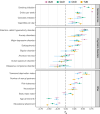The genetic landscape of substance use disorders
- PMID: 38811691
- PMCID: PMC11541208
- DOI: 10.1038/s41380-024-02547-z
The genetic landscape of substance use disorders
Abstract
Substance use disorders represent a significant public health concern with considerable socioeconomic implications worldwide. Twin and family-based studies have long established a heritable component underlying these disorders. In recent years, genome-wide association studies of large, broadly phenotyped samples have identified regions of the genome that harbour genetic risk variants associated with substance use disorders. These regions have enabled the discovery of putative causal genes and improved our understanding of genetic relationships among substance use disorders and other traits. Furthermore, the integration of these data with clinical information has yielded promising insights into how individuals respond to medications, allowing for the development of personalized treatment approaches based on an individual's genetic profile. This review article provides an overview of recent advances in the genetics of substance use disorders and demonstrates how genetic data may be used to reduce the burden of disease and improve public health outcomes.
© 2024. The Author(s).
Conflict of interest statement
The authors declare no competing interests.
Figures




Similar articles
-
Genetic liability for substance use associated with medical comorbidities in electronic health records of African- and European-ancestry individuals.Addict Biol. 2022 Jan;27(1):e13099. doi: 10.1111/adb.13099. Epub 2021 Oct 5. Addict Biol. 2022. PMID: 34611967 Free PMC article.
-
Genetics of substance use disorders: a review.Psychol Med. 2021 Oct;51(13):2189-2200. doi: 10.1017/S0033291721000969. Epub 2021 Apr 21. Psychol Med. 2021. PMID: 33879270 Free PMC article.
-
Planning a genome-wide association study: points to consider.Ann Med. 2011;43(6):451-60. doi: 10.3109/07853890.2011.573803. Epub 2011 May 19. Ann Med. 2011. PMID: 21595511 Review.
-
A brief history of research on the genetics of alcohol and other drug use disorders.J Stud Alcohol Drugs Suppl. 2014;75(17):59-67. doi: 10.15288/jsads.2014.s17.59. J Stud Alcohol Drugs Suppl. 2014. PMID: 24565312 Free PMC article. Review.
-
An integrative systems-based analysis of substance use: eQTL-informed gene-based tests, gene networks, and biological mechanisms.Am J Med Genet B Neuropsychiatr Genet. 2021 Apr;186(3):162-172. doi: 10.1002/ajmg.b.32829. Epub 2020 Dec 23. Am J Med Genet B Neuropsychiatr Genet. 2021. PMID: 33369091 Free PMC article.
Cited by
-
Spectral divergence prioritizes key classes, genes, and pathways shared between substance use disorders and cardiovascular disease.Front Neurosci. 2025 Jul 22;19:1572243. doi: 10.3389/fnins.2025.1572243. eCollection 2025. Front Neurosci. 2025. PMID: 40766907 Free PMC article.
-
Genetic liability to major psychiatric disorders contributes to multi-faceted quality of life outcomes in children and adults.Transl Psychiatry. 2025 Jul 7;15(1):232. doi: 10.1038/s41398-025-03443-y. Transl Psychiatry. 2025. PMID: 40624012 Free PMC article.
-
Influence of multi-species data on gene-disease associations in substance use disorder using random walk with restart models.PLoS One. 2025 Jun 16;20(6):e0325201. doi: 10.1371/journal.pone.0325201. eCollection 2025. PLoS One. 2025. PMID: 40522980 Free PMC article.
References
-
- American Psychiatric Association D, Association AP Diagnostic and statistical manual of mental disorders: DSM-5. vol. 5. Washington, DC: American Psychiatric Association; 2013.
-
- Gaziano JM, Concato J, Brophy M, Fiore L, Pyarajan S, Breeling J, et al. Million Veteran Program: a mega-biobank to study genetic influences on health and disease. J Clin Epidemiol. 2016;70:214–23. - PubMed
Publication types
MeSH terms
Grants and funding
LinkOut - more resources
Full Text Sources
Medical

